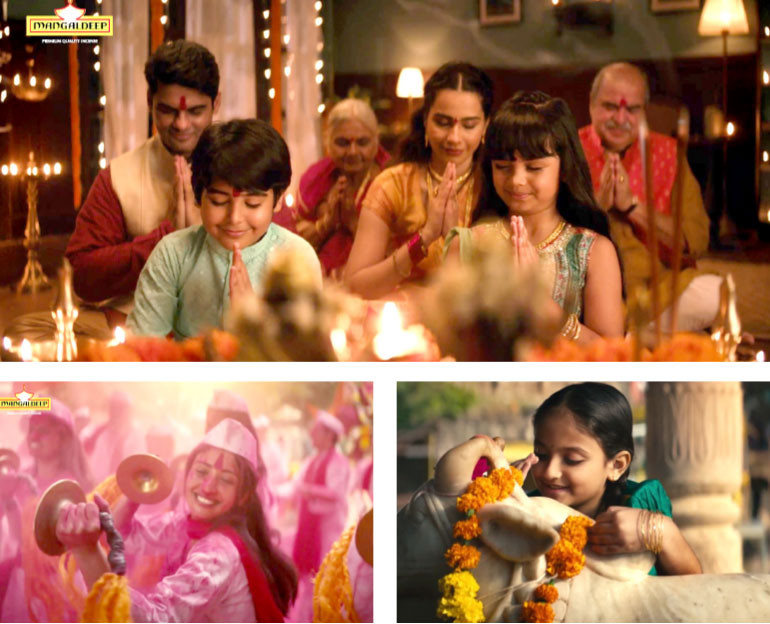Q] How would you define Mangaldeep’s journey over the years?
Mangaldeep, with over 20 years in the business, operates in a highly fragmented industry with over 2,000 manufacturers due to low capital requirements. When ITC entered this market, our goals were to generate employment and transform the category by introducing credibility in quality and materials. Today, Mangaldeep boasts the highest household penetration in India, reaching over 25% annually. From the start, Mangaldeep has relied on mass media marketing to create brand appeal, rather than merely pushing products into the market. This enduring philosophy has guided our approach to the category throughout the years.
Q] What was the inspiration behind the ‘Dil se Karo Baat, Bhagwan ke Saath’ campaign? What kind of budget was allocated for the campaign?
Through consumer research, we found that people pray in diverse ways and places—beyond temples and puja rooms, often in moments of need or during significant events. This behaviour reflects a universal truth about personal connection with God, who is often viewed as a close friend. Our campaign, ‘Dil Se Karo Baat, Bhagwan Ke Saath,’ captures this insight by highlighting the various ways people connect with God, emphasising their relationship as one based on friendship and trust. The campaign aims to resonate emotionally with both current and future consumers, embedding these universal truths into a contemporary narrative.
While budgets are constrained, we allocate about 40% of our overall marketing spend to this campaign for substantial coverage. The campaign has been running since July and will continue to run till November, covering key markets. To expand our reach, we are using connected TV, digital platforms like YouTube, and potentially multiplex integrations to target audiences who no longer watch traditional TV. This comprehensive approach aims to maximise the campaign’s impact during the festive period.

Q] Currently, which are your strongest growth markets in India? And what is your current market share in the Agarbatti segment?
Our strongest markets are the South, East, and North regions, where Mangaldeep ranks between first and third. In the North, we lead as the top dhoop brand. We are also emerging in the Western region. We use a leadership strategy to dominate one state before expanding to new markets, focusing on core (top three) and emerging markets. In growing markets, we adapt to local consumer needs and offer unique products. The industry is fragmented, with the top players holding no more than 20–25% market share collectively. Mangaldeep is number two in value proposition but number one in volume, being the highest-penetrated brand across all price points.
Q] How does your distribution strategy look? What are your primary distribution challenges for reaching Agarbatti users or target consumers?
Our distribution strategy for Mangaldeep mirrors other FMCG categories, with 80% of business from general trade. Organised retail and e-commerce are rapidly growing channels for us, and we excel in these areas due to our understanding of consumer behaviour.
We see high growth in organised retail and e-commerce, with our presence doubling annually on platforms like Blinkit, Swiggy, and Zepto. We’ve successfully shifted consumer habits from traditional Pooja stores to online purchases by collaborating with e-commerce platforms. We anticipate that organised retail and digital channels will make up 30–35% of our business in the next five years.
Q] How do your global expansion plans look?
Currently, we are prioritising growth in India, where we see substantial potential over the next two to three years. Our resources are focused on the domestic market for now. We plan to expand internationally soon, which should further boost our growth rates.
Q] How do you ensure that your marketing strategies align with the beliefs and faiths of your target audience? What approaches do you use to maintain this balance?
Our consumer-focused approach involves household surveys and consumer panels in five Indian metros to understand core trends and regional nuances. We also use ITC’s Bangalore command centre to analyse online consumer behaviour and drive our product development. Digital and social media platforms allow for precise targeting and customisation of content, helping us adapt to changing consumer preferences. For instance, increased disposable income and exposure to modern fragrances have led to new scent preferences. To capitalise on this, we introduced “Scent,” a new sub-brand offering modern, aspirational fragrances developed in collaboration with international fragrance houses. “Scent” is rapidly growing, reflecting our ability to innovate and respond to market trends effectively.
Q] What growth have you witnessed in the spirituality segment over the past few years? How has this growth impacted brands like Mangaldeep and the overall agarbatti industry?
Over the past three to four years, the incense category has grown at 6 to 8% annually, driven by up-trading and increased value consumption, despite its 90% household penetration. The COVID-19 pandemic also boosted interest in incense due to increased time at home and a resurgence in spiritual practices. Mangaldeep is growing at twice the category average, indicating strong market share gains. Emerging trends include bamboo-less incense sticks, which cater to specific cultural preferences, and the growing acceptance of Sambrani in new regions. Currently, the average household spends INR 30 to INR 40 rupees per month on incense, with the category size at INR 11,000 crores. If spending increases to INR200 per month, the category could expand to INR 50,000 crores. Mangaldeep aims to sustain its 2X growth rate and continue shaping the future of the category.























